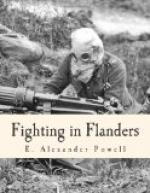We were the first foreigners to see Aerschot, or rather what was left of Aerschot after it had been sacked and burned by the Germans. A few days before Aerschot had been a prosperous and happy town of ten thousand people. When we saw it it was but a heap of smoking ruins, garrisoned by a battalion of German soldiers, and with its population consisting of half a hundred white-faced women. In many parts of the world I have seen many terrible and revolting things, but nothing so ghastly, so horrifying as Aerschot. Quite two-thirds of the houses had been burned and showed unmistakable signs of having been sacked by a maddened soldiery before they were burned. Everywhere were the ghastly evidences. Doors had been smashed in with rifle-butts and boot-heels; windows had been broken; furniture had been wantonly destroyed; pictures had been torn from the walls; mattresses had been ripped open with bayonets in search of valuables; drawers had been emptied upon the floors; the outer walls of the houses were spattered with blood and pock-marked with bullets; the sidewalks were slippery with broken wine-bottles; the streets were strewn with women’s clothing. It needed no one to tell us the details of that orgy of blood and lust. The story was so plainly written that anyone could read it.
For a mile we drove the car slowly between the blackened walls of fire-gutted buildings. This was no accidental conflagration, mind you, for scattered here and there were houses which stood undamaged and in every such case there was scrawled with chalk upon their doors “Gute Leute. Nicht zu plundern.” (Good people. Do not plunder.)
The Germans went about the work of house-burning as systematically as they did everything else. They had various devices for starting conflagrations, all of them effective. At Aerschot and Louvain they broke the windows of the houses and threw in sticks which had been soaked in oil and dipped in sulphur. Elsewhere they used tiny, black tablets, about the size of cough lozenges, made of some highly inflammable composition, to which they touched a match. At Termonde, which they destroyed in spite of the fact that the inhabitants had evacuated the city before their arrival, they used a motor-car equipped with a large tank for petrol, a pump, a hose, and a spraying-nozzle. The car was run slowly through the streets, one soldier working the pump and another spraying the fronts of the houses. Then they set fire to them. Oh, yes, they were very methodical about it all, those Germans.
Despite the scowls of the soldiers, I attempted to talk with some of the women huddled in front of a bakery waiting for a distribution of bread, but the poor creatures were too terror-stricken to do more than stare at us with wide, beseeching eyes. Those eyes will always haunt me. I wonder if they do not sometimes haunt the Germans. But a little episode that occurred as we were leaving the city did more than anything else to bring home the horror of




